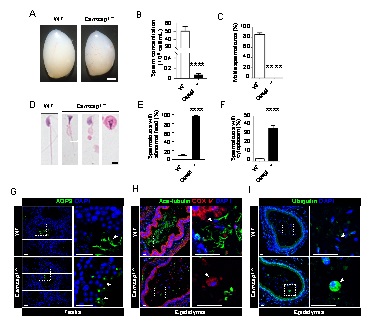Chinese Academy of Sciences
Researchers led by MENG Wenxiang from the Institute of Genetics and Developmental Biology of the Chinese Academy of Sciences have shown that knocking out of the calmodulin-regulated spectrin-associated protein 1 (CAMSAP 1) gene, which are associated with the minus ends of non-centrosomal microtubules, in mice resulted in typical oligoasthenoteratozoospermia, including abnormal sperm head and tail, reduced sperm quantity, decreased sperm motility, and male infertility.
The results were published in PNAS on Oct. 30.

Figure 1. Abnormal Sperm Development in CAMSAP1-/- Mice (Image by IGDB)
A manchette is a transient structure during sperm morphogenesis that consists mainly of non-centrosomal microtubules. Regulation of the manchette is essential for sperm formation. Disruption of manchette microtubules can lead to sperm abnormalities and male infertility.
Although the manchette was discovered more than half a century ago, very little is known about the protein composition at the distal end of manchette microtubules and how it is dynamically regulated during sperm morphogenesis.
In this study, histological and ultrastructural observations of mouse testis and epididymis tissues have revealed that CAMSAP1 localizes to the distal end of manchette microtubules. The absence of CAMSAP1 results in abnormal elongation of manchette microtubules during spermatid shaping, a significant delay in the disassembly of CAMSAP1-deficient manchette microtubules, and increased acetylation modification of microtubules.
After separation and enrichment of manchette components, proteomic analysis and further studies revealed that the loss of CAMSAP1 leads to abnormal localization of key proteins such as CEP170 and KIF2A at the distal end of the manchette.
As a result, anchoring is disrupted and the disassembly of manchette microtubules is delayed.
This study reveals a novel mechanism for the dynamic regulation of manchette microtubules during sperm development. It is found that CAMSAP1 localizes to the distal end of manchette microtubules, recruiting CEP170 and KIF2A to regulate the anchoring and disassembly of manchette microtubules. This ensures the normal progression of sperm development. This research deepens our understanding of the pathogenesis of teratozoospermia.
This study also provides a theoretical basis for clinical research and therapeutic approaches for treating teratozoospermia.
This work was supported by the National Natural Science Foundation of China and the National Key Research and Development Program of China.

Figure 2. Dynamic Regulation Mechanism of Manchette Microtubules (Image by IGDB)
/Public Release. This material from the originating organization/author(s) might be of the point-in-time nature, and edited for clarity, style and length. Mirage.News does not take institutional positions or sides, and all views, positions, and conclusions expressed herein are solely those of the author(s).View in full here.






